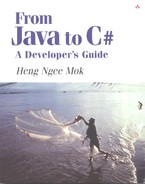Chapter 27. C# attributes
C# attributes [1],[2] are a new feature with no equivalent in Java. [3] Put simply, C# attributes are comment-like tags enclosed in square brackets used to label or mark a class, interface, assembly, method, event, field, delegate, or method parameter in codes. Attributes enable these entities in source codes to be tagged with additional declarative information. These tags can be 'read' during runtime using C#'s built-in support for reflection.
[1] Do not be confused over the use of the term 'attribute'. In OO terminology (and also commonly in Java) the terms 'attribute', 'field', and 'property' are often used interchangeably to mean a class's field. In C#, 'fields' and 'properties' refer to different class members, and 'attributes' are special constructs used to tag (or label) classes, interfaces, or class members.
[2] If you have ever done any COM+ programming before, you might have used a less refined form of attributes too. COM attributes, like 'transaction_required' or 'queueable', are added to a COM component's IDL to provide transaction support or MSMQ functionality. In .NET, attributes are coded within the source code itself, instead of in a separate IDL file.
[3] The nearest Java feature to C# attributes is marker interfaces. Marker interfaces are interfaces which do not contain any members, and are only used during runtime to determine if a particular object is of this interface type. The most famous marker interfaces in Java are probably java.lang.Serializable and java.lang.Cloneable. However, as you will see, comparing marker interfaces with C# attributes is like comparing a Californian Redwood with a bean sprout.
You can also think of an attribute as a language construct that decorates a class entity [4] with additional information which can be used by the CLR (standard attributes) or your own codes (custom attributes).
[4] I use the term 'class entity' in this chapter (and the next) to refer to classes, methods, interfaces, method parameters, fields, properties, indexes, delegates, events, and method parameters which can be marked by an attribute. The 'marked' entity is known as the attribute target.
Attributes is not an easy topic to understand, and writing custom attributes can be very complex. I shall start by looking at an example, and then move on to explain what is happening. After giving you a general grasp of the idea, I shall then discuss several standard predefined attributes you can use. Writing your own custom attributes will be covered in the next chapter.
